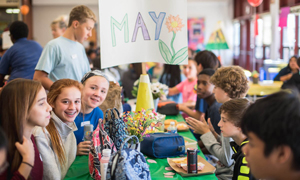 Monita K. Bell, senior editor at Teaching Tolerance, and Stephen Sye, associate executive director at ILA, joined host Larry Jacobs on Education Talk Radio yesterday to unpack some of the ideas that drove ILA’s first social justice panel, which has amassed more than 8,000 views on Facebook Live to date.
Monita K. Bell, senior editor at Teaching Tolerance, and Stephen Sye, associate executive director at ILA, joined host Larry Jacobs on Education Talk Radio yesterday to unpack some of the ideas that drove ILA’s first social justice panel, which has amassed more than 8,000 views on Facebook Live to date.
The panel, “Disrupting a Destructive Cycle: How Literacy Drives Social Change,” was inspired by an on-the-fly addition to the ILA 2016 Conference & Exhibits, which took place days after the shootings of Philando Castile and Alton Sterling, the Dallas sniper attack, and the massacre at Pulse nightclub in Orlando.
“We just found a room at our conference and invited people to come have difficult conversations,” said Sye. “These educators had students who were coming to them with questions.”
Moderated by Nikole Hannah-Jones, an investigative reporter covering racial injustice for The New York Times Magazine, the panelists at the ILA 2017 panel, including Bell, discussed how they are using literacy to disrupt cycles of inequality and affect social change, starting in the classroom.
“We realized there was a hunger for this information,” Sye said.
Literacy: the bottom line of education
When asked how she became involved in the panel, Bell discussed the social and political contexts of literacy, and how it’s critical to her work at Teaching Tolerance, a project of the Southern Poverty Law Center. She recognizes a broader definition of literacy that transcends the traditional notions of reading and writing.
“Literacy runs through everything else. It’s reading—but it’s not just reading books—it’s reading the world around you,” she said.
Sye agreed that literacy has an “all-encompassing” definition that is constantly evolving and expanding to include new forms. He believes that these nontraditional forms—particularly media, digital, and political literacies—empower students to meaningfully participate in social and political issues.
“At ILA, we think that literacy is a civil right,” Sye said. “We see it as a way to ensure social justice and to enact social change. It’s a pathway to civic engagement.”
It starts with the teachers
Educators have a responsibility to deconstruct biases in the classroom—starting with their own, according to Sye. He said that honest self-reflection is the first step in dismantling systemic bias.
“How can you change the landscape without first understanding the landscape?” Sye asked.
Sye highlighted tools that help educators to identify their own prejudices, such as Hidden Bias Tests. He also stressed the importance of professional development experiences and online resources, such as ILA’s research-based position statements, policy briefs, and advocacy toolkits, as well as Teaching Tolerance’s learning plans, perspectives texts, teaching strategies, and more.
Passing the torch
Although she believes that social change starts with educators, Bell said her ultimate goal is to empower them to “pass the torch” to the next generation of changemakers.
“When everyone’s not getting those rights, students need to have a lens to see that, to question it, to challenge it, and then [to] take action against it,” Bell said.
On the heels of the 2016 U.S. election, the Southern Poverty Law Center administered a survey about school climate to K–12 educators from across the country. The report, titled “The Trump Effect,” summarized 10,000 responses, many citing incidents of verbal harassment, racial slurs, derogatory language, and threats involving swastikas, Nazi salutes, and Confederate flags.
Bell said these events illustrate that social progress is not linear; for every step forward, there’s pushback. She said teachers have a responsibility to make students aware of their role as future leaders.
“It takes committed action for things to change. It’s not inevitable,” said Bell. “Now we know that the rights that we celebrated with the 50th anniversary of the Civil Rights Act, some of those rights are being scaled back.”
Back to school: teaching tolerance from day one
Jacobs asked Bell to share tips for educators who are preparing to teach tolerance in the upcoming school year.
Bell said that Teaching Tolerance recently unveiled a website redesign with new features such as “The Moment,” which currently offers back-to-school resources, including a guide to instituting Mix It Up at Lunch Day, a campaign that encourages students to cross social boundaries in the cafeteria.
Another guide, “A New Set of Rules,” helps teachers to engage their students in building a classroom constitution that governs their own behaviors, interactions, and mediation activities.
Bell said that when students work together to define their own rules and responsibilities, they are more likely to hold themselves and their peers accountable. By establishing a culture of cooperation early on, students are more willing to participate in difficult conversations, according to Bell.
“Part of that is hearing each other’s stories,” she said. “Someone just said on our advisory board last week, ‘Once you hear someone else’s story, it’s harder for you to hurt them.’”
Listen to the archived recording of the radio segment here.
Alina O’Donnell is the editor of Literacy Daily.